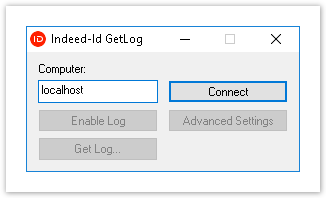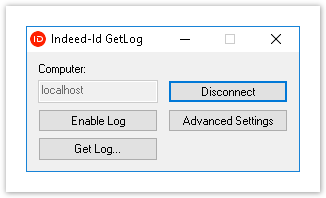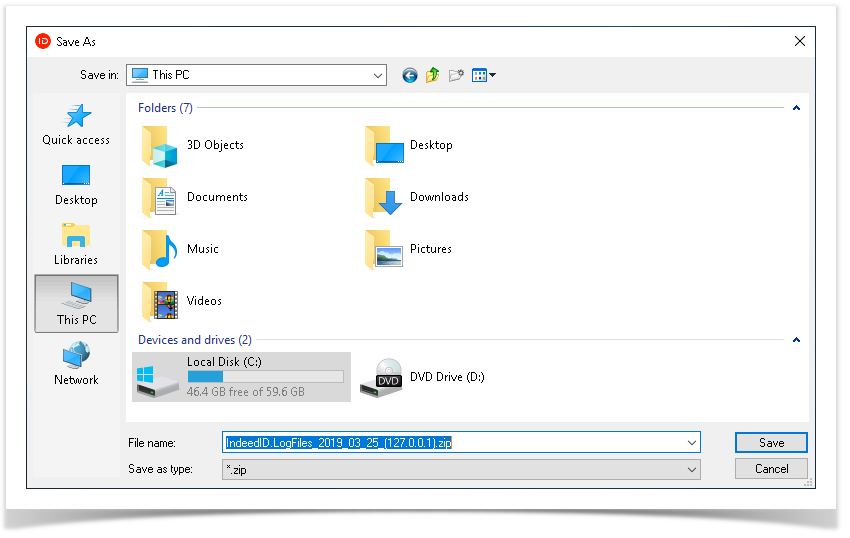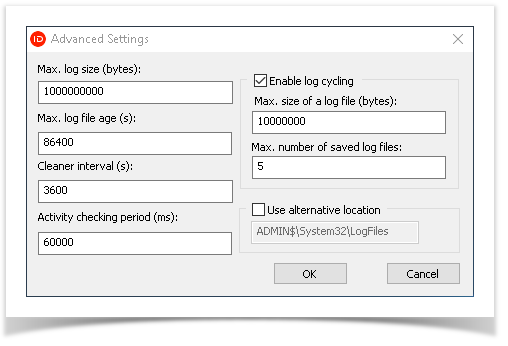Versions Compared
Key
- This line was added.
- This line was removed.
- Formatting was changed.
The Indeed-Id GetLog application is designed for local and remote collection of log files of Indeed ID company software products.
Run the IndeedID.GetLog.exe application from Logging folder of Indeed-Id installation package (Figure 1).
 Image Removed
Image Removed
 Image Added
Image Added
| Warning |
|---|
The Indeed-Id GetLog utility needs local administrator privileges to operate properly. For Windows Vista and later versions, the utility is run under administrator rights (Run As Administrator). |
Connection to PC
To connect the application to PC, proceed as follows:
- Enter the name or IP address of the remote PC to the Computer field. To connect to local PC, enter localhost or IP address 127.0.0.1.
- Click Connect to connect to specified computer. After connection is established, the following buttons become active: Enable Log/Disable Log, Get Log..., Advanced Settings and Disconnect. See Figure 2.
 Image Removed
Image Removed
Figure 2 – Connection to PC.
 Image Added
Image Added
| Warning |
|---|
To connect to remote PC running under Windows Vista or higher, make sure that the Windows Management Instrumentation (WMI) service is running and is not disabled on that remote PC. For more details see Log collection errors and methods of elimination section. |
Log enabling or disabling, log collection
To enable or disable logs, proceed as follows:
- Connect to computer.
- To enable logging, click Enable Log.
- If logging is required to reveal a problem root cause, then perform the actions needed to reproduce the problem.
- To disable logging, click Disable Log.
- To obtain logs, click Get Log...
- Specify the folder to save a zip file to and click Save (Figure 3).
Image Removed
Figure 3 – Log saving.
 Image Added
Image Added
| Info |
|---|
Log files are written to \WINDOWS\System32\LogFiles\Indeed-Id folder by default. To access a remote PC logs, the network folder ADMIN$\System32\LogFiles\Indeed-Id Is used by default. You can specify a folder of your choice with the Use alternative location option of Advanced Settings section. |
7. To disconnect from the computer, click Disconnect and close the application.
Advanced settings
To switch to advanced settings, click Advanced Settings in the main window of Indeed-Id GetLog. The following settings are available in the Advanced Settings window (see Figure 4):
 Image Removed
Image Removed
 Image Added
Image Added
- Max. log size (bytes) defines the maximum size of all files in the folder in bytes. Default value is 1 GB. When the defined value is reached, the folder contents is automatically deleted, except for the files whose last modification date does not exceed the value of Max. log file age field.
- Max. log file age (s) defines log file “age” in seconds. If the size of all logfiles in the folder exceeds the Max.log size value, then log files are deleted if older than Max.log file age.
For example: maximum size of all log files in ...LogFiles\Indeed-Id folder is 1 GB (Max.log size (bytes) = 1000000000), and log file “age” is 24 hours (Max.log file age (s) = 86400). When the folder size exceeds 1 Gb, all the files would be deleted, except for those created within the last 24 hours. - Cleaner interval (s) is the interval of log folder size check in seconds. Default value is 1 hour (3600 seconds).
- Activity checking period (ms) is the interval of logging activity check in milliseconds. An Indeed ID Before starting to record logs, the Indeed AM component (sayfor instance, Indeed -Id AM ESSO Agent) checks whether logging is enabled at the workstation before starting log recordingin question. The default interval is 1 minute (60 000 milliseconds).
- Enable log cycling defines whether cyclic logging is enabled. When option is active, each process logs are recorded as per defined settings of log file size and number.
Max. size of a log file (bytes) defines maximum size of a log file in bytes. Default value is 10 Mb (1000000 bytes). After the defined size is achieved, the log file contents is overwritten with new data.
Max. number of saved log files defines the maximum quantity of log files to store.The default value is 5 (the current file is not counted in). If defined file number is exceeded, the oldest one is deleted, and logging is continued to a newly created file.
- Use alternative location defines an alternative folder for logging. If disabled, logs are placed to default folders:
Local path: \WINDOWS\System32\LogFiles\Indeed-Id
Network path: ADMIN$\System32\LogFiles\Indeed-Id